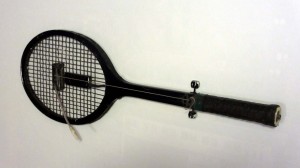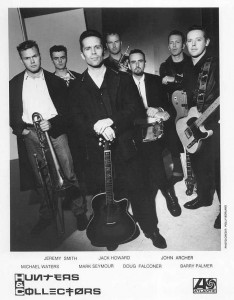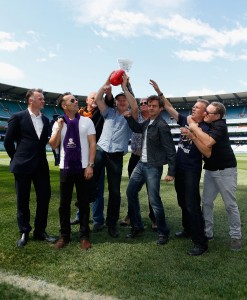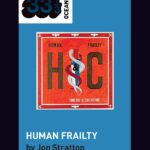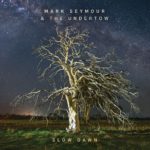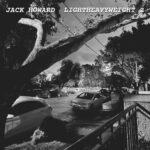Biography
Hunters and Collectors were an eight member Australian rock collective active from 1981 to 1998 with infrequent later reunions. Their style evolved from early art-funk before a bass and drum driven pub rock phase and finally guitar driven pop rock. Hunters and Collectors live and studio albums are available new.
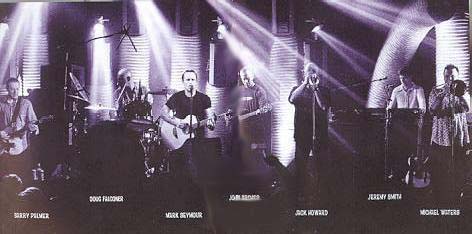
Selina’s, Sydney, 1998 (from Under One Roof)
Members
The ‘classic’ Hunters and Collectors line up:
- John Archer – bass guitar, P.A., backing vocals (1981-1998; all reunions).
- Doug Falconer – drums, percussion, programming, backing vocals (1981-1998; all reunions).
- Jack Howard – trumpet, keyboards, backing vocals (1981-1998; all reunions).
- Rob Miles – live sound/mixing, art/design (1981-1998; all reunions).
- Barry Palmer – lead guitar (1988-1998; all reunions).
- Mark Seymour – lead vocal, lyrics, guitar (1981-1998; all reunions).
- Jeremy Smith – french horn, guitars, keyboards, programming, backing vocals (1981-1998; all reunions).
- Michael Waters – trombone, keyboards, finance (1981-1998; all reunions).
Additional members:
- Nigel Crocker – trombone (1981-1982).
- Geoff Crosby – keyboards, artwork (1981-1985).
- Martin Lubran – guitar (1982-1983).
- Andy Lynn – trumpet (1981-1982).
- Chris Malherbe – trumpet (1981-1982).
- Greg Perano – percussion (1981-1983).
- Ray Tosti-Gueira – guitar, backing vocals (1981-1982).
Biography
The journey that has taken Hunters & Collectors from esoteric art-funk innovators to Australia’s greatest pub-rock exponents has been a fascinating one to say the least. The band’s early records were full of challenging, noisy rock, bleak imagery, gripping drama and slithery funk. By the 1986 album Human Frailty and single “Say Goodbye”, the band had stripped away unnecessary excess to arrive at a sound that combined equal parts refried boogie-rock and lyric paradoxes.
Front man Mark Seymour became the “thinking woman’s sex symbol” with his blue labourer’s singlet, bulging biceps, introspective angst and impassioned vocals. There was a double irony in the sight of beer-soaked boys in suburban pubs across the land bellowing about not feeling like a woman any more, while the girls danced relentlessly up the back. Hunters & Collectors’ great achievement was to lay bare human emotions in the intensely ritualistic milieu of the pub-rock gig.
– Ian McFarlane, The Encyclopaedia of Australian Rock and Pop, 2000
Hunters and Collectors began life immersed in a typical Australian academic environment of alcohol and loud rock.
John Archer, Mark Seymour and Robert Miles were friends at a University of Melbourne residential college called Ormond College in the 1970’s. After John and Robert joked around about forming a band, they eventually formed the Schnortts. This wholly unsuccessful circa 1978 adventure was the first band to contain Mark Seymour, John Archer, Doug Falconer and Robert Miles. The inspiration for the name Schnortts came from a Belgian tennis racquet of Rob’s, used primarily for air guitar, that John converted into an electric tennis racquet.
Many drinks later, the core of what was to later become Hunters and Collectors formed The Jetsonnes in September 1979. The line-up comprised of Mark Seymour (guitar), John Archer (bass), Doug Falconer (drums), Ray Tosti-Gueira (guitar), Margot O’Neill (vocals) and Robert Miles (live sound and artwork). The band had a light, bouncy pop sound and only recorded one track called News-paper, which was found on a gig giveaway 7″ single that also featured Miniskirts in Moscow by the International Exiles.
The Jetsonnes played in the Melbourne area for about a year before disbanding in September 1980. Margo left to pursue journalism while the remaining members soon reappeared in May 1981 with a new more radical concept. Mark introduced members Geoff Crosby (keyboards) and Greg Perano (percussion) and became the vocalist. A massive horn section, initially comprising of six members, was soon added to complete the new band. Robert Miles became a full member to handle sound and mixing of the eleven member band.
The Melbourne based band was named by Greg Perano after the German band Can’s track Hunters and Collectors from their 1975 album Landed. The new band counted among it’s influences Can, Talking Heads, David Byrne, X and Brian Eno.

Can – Hunters & Collectors 7″ Single
Hunters and Collectors made their live debut on the 15th of May 1981 at the Seaview Ballroom in Melbourne. Quickly earning a reputation as the ‘next big thing’, the Hunna’s became renowned for their chaotic, intense tribal performances. They were signed up in Australia by Mushroom Records sub-label White, which they remained with throughout their career.
Throughout the early era, studio recordings and releases lagged noticeably behind live performances. The January 1982 released debut EP World Of Stone (World Of Stone / Watcher / Loinclothing) reflected works from mid 1981, but still earned the band a minor hit on the Australian music charts (#50).
The self titled debut studio album arrived in mid 1982, to critical acclaim and reasonable sales in Australia (#21, Gold) and in New Zealand. The album showcased intense, percussive instrumental sections featuring everything from the massive brass section to an empty gas cylinder. It featured the bands first truly excellent song, the seven and a half minute Talking To A Stranger (#59). The single was also eventually released in the UK in various forms, sparking a cult following. The obscure but brilliant display of confusion and imagery in the Richard Lowenstein video clip for Talking To A Stranger became a classic. The World Of Stone EP can be found on most CD and digital versions of this album.
Following the Hunters and Collectors album, Tosti-Gueira was replaced by Martin Lubran on guitar while the ‘Horns Of Contempt’ brass section was pared down to Howard, Smith and Waters. A second EP Payload (Lumps Of Lead / Towtruck / Droptank / Mouthtrap) appeared before the end of 1982. An eerie apocalyptic video clip for Lumps Of Lead was made for the EP featuring visions of the demise of capitalism.
Hunters and Collectors spent six miserable months of 1983 in the UK after which they recorded their second studio album The Fireman’s Curse (#77, Gold) in West Germany with Conny Plank. The band and critical view of the album is reflected in it’s minimal representation in compilation albums, though Curse and the singles Judas Sheep and Sway are listenable. Live performances of the era remain well regarded, but the personal and artistic differences can be felt tearing the band apart. By the end of 1983, the bands future was uncertain with Perano and Lubran leaving the band.
Following a period of re-evaluation, Hunters and Collectors re-emerged in July 1984 a smaller but stronger eight member band comprising Archer, Crosby, Falconer, Howard, Miles, Seymour, Smith and Waters. Influenced by the likes of Ian Rilen and X, the reinvigorated band released the classic album The Jaws Of Life (#89, Gold), featuring a dominant drum and bass section. When combined with vivid Australian imagery from Mark Seymour’s more directed lyrics and raw vocals, The Jaws Of Life was an accomplished album. The classic double a-sided single The Slab / Carry Me gave a taste of an album full of hard hitting tracks that included 42 Wheels, the fun The Way To Go Out and the dark ghost town ode Little Chalkie. The Payload EP can be found on most CD and digital versions of The Jaws Of Life.
After three studio albums and two EP’s, Hunters and Collectors released their first live album in May 1985, The Way To Go Out (#76, Gold). Preceding this album in November 1984 was the the first of three single releases of Throw Your Arms Around Me, this as a relatively unnoticed live recorded 7″ single. Following The Way To Go Out, Michael Waters (already on trombone) took over keyboards from the departing Crosby. It was also at this time that Hunters and Collectors linked up with long term manager Michael Roberts.
Following a band decision to appeal to a broader audience, Hunters and Collectors released Human Frailty (#10, Double Platinum) in May 1986. The album, themed on human relationships, presented the bass and drums of The Jaws Of Life in a focused, melodic and ultimately successful context. Human Frailty brought the Hunna’s mainstream attention in Australia with the singles Say Goodbye (#24), a cleaner, studio version of Throw Your Arms Around Me (#49), Everything’s On Fire (#78) and Is There Anybody In There?. Human Frailty was released outside of Australia under I.R.S. Records. Human Frailty continues to receive accolades to this day, featuring in many essential Australian album lists.
The next step for the Hunna’s was two solid tours of the USA and the Living Daylight EP (#41, Living Daylight / January Rain / Inside A Fireball). Most CD and digital versions of Human Frailty contain this EP.
With a further emphasis on drumming, a changed production style and more outward facing themes, Hunters and Collectors released the Australian only What’s A Few Men? album in April 1987 (#16, Platinum). Mark Seymour took the album’s title from Albert Facey’s memoir, A Fortunate Life. The title track was about mistreatment Australian soldiers received in World War 1 at the hands of English military leaders. The album contained the singles Do You See What I See? (#33, November 1987) and Still Hanging ‘Round (February 1988).
Targeting the lucrative US market, What’s A Few Men? was remixed with some tracks added (including Back On The Breadline) and some tracks removed. This more produced effort, Fate (September 1988), failed to make a significant dint in the market is was intended for but did yield the single Back On The Breadline (#37). Fate replaced What’s A Few Men? in Australian stores in April 1991 but was in turn replaced by an expanded What’s A Few Men? in August 2003.
Having provided guitar on Fate, Harem Scarem guitarist Barry Palmer formally joined the band in 1988. The ‘classic’ Hunters lineup, that endured up to and including the 2017 reunion gig, was formed at this point. This eight member line-up includes Archer, Falconer, Howard, Miles, Palmer, Seymour, Smith and Waters.
Their next album, released at the end of 1989, was Ghost Nation (#10, Double Platinum). The album contained the singles When The River Runs Dry (#23), Turn A Blind Eye (#42), The Way You Live (#75) and Love All Over Again. Nominated for six ARIA awards in 1989, the only win was for Robert Miles’ artwork (which Rob uses as a bookend). The lack of credit came as a surprise and was a motivation for changing the ARIA award voting process for the future. Hunters and Collectors were named Australian Band of the Year in Rolling Stone in 1990 after their support gig on Midnight Oil’s 1990 tour.
1990 also saw the release of Collected Works (#8, Double Platinum), a ‘best of’ compilation album covering all Hunters and Collectors works to date. The overseas I.R.S. version was drawn from Human Frailty and Fate eras only. In Australia the Collected Works album was a more varied set of songs reflecting band preferences that covered up to and including Ghost Nation. Australia also enjoyed a video version, which contained more songs. The Australian versions of Collected Works also contained a new polished and radio friendly version of Throw Your Arms Around Me (1990) which was released as a single (#34).
The early albums (Hunters and Collectors, The Fireman’s Curse, The Jaws Of Life, The Way To Go Out) were released on CD in Australia in 1991. Initially this was combined as the Skin, Bones & Bolts box set (#79) before the albums were individually issued. In these new releases, the World Of Stone EP was attached to the Hunters and Collectors album while the Payload EP was attached to The Jaws Of Life album. The artwork changed, particularly in the case of The Jaws Of Life, which no longer showed the collage of Australian imagery from the LP version. A Collected Works tour followed, bringing back Talking To A Stranger to the set list after an absence of many years.
In September 1991 Hunters and Collectors gave an early taste of their next album with the single Where Do You Go? (#33). Mark Seymour and Paul Kelly joined together for the May 1992 single Hey Boys (#71), lifted from the Garbo movie soundtrack.
Late in 1992 the full assault for what would be Hunters and Collectors most plentiful singles era in Australia began. The surprising Head Above Water came out in July (#64) before the political We The People (#70). Then in October the Hunna’s most commercial studio effort to date, Cut (#6, Double Platinum), was released. Cut was produced by Don Gehman of R.E.M. and John Mellencamp fame. Album sales rose as the string of hit singles continued with True Tears Of Joy (#14, November 1992), Holy Grail (#20, March 1993) and Imaginary Girl (#82, August 1993). Cut yielded an impressive six top 100 hits, while also featuring great album tracks including Grindstone, Edge Of Nowhere and Hear No Evil.
Partly in response to the lack of international acclaim for Cut, Hunters and Collectors quickly recorded and released Demon Flower in May 1994 (#2). The first single from it was Easy (#38, May 1994), which featured a humorous video involving toy cars. Commercial singles were also released for Back In The Hole (#105) and Drop In The Ocean (#111), along with a promotional single for The One and Only You. Demon Flower placed a new emphasis on Barry Palmer’s electric guitars. The result is controversial, with many enjoying Barry’s crushing guitar work while others preferring the more traditional Hunna’s sound.
A cover of the Saint’s song Know Your Product was put on the Earth Music compilation album in June 1994. During the time of Demon Flower, a bonus CD EP Live Demons In Amsterdam was given away with new Hunters and Collectors albums.
The band toured Europe in support of Demon Flower and then took a break. During this time the double live set Living In Large Rooms and Lounges was issued in December 1995 (#45, Gold). One of the CD’s was recorded live at the Continental (acoustic) and the other disc contains tracks recorded live in pubs. An accompanying single titled Living Single In Large Rooms and Lounges also appeared (#123). The material covered is weighted towards Human Frailty and Demon Flower but also contained tracks from The Jaws Of Life, What’s A Few Men?, Ghost Nation and Cut.
During the break Barry Palmer formed the band Deadstar. Mark Seymour also recorded and released his first solo album King Without A Clue. A moderate amount of controversy surrounded these decisions at the time.
By the time 1997 came around, a split was inevitable. There were external family commitments, long running internal differences, long running frustrations with cracking overseas markets and it was simply time to ‘call it a day’. Instead of issuing a ‘best of’ compilation, Hunters and Collectors recorded their last studio album Juggernaut (#36) and released it in February 1998. It contained the Mark Seymour and Paul Kelly penned single Suit Your Style (#157). The sound on Juggernaut was softer with hints of Crowded House. Stand-out tracks include the promotional single Higher Plane, the ode to fans True Believers, Wasted In The Sun and the closer Long Way To The Water.
Hunters and Collectors launched one final grueling tour aptly titled Say Goodbye. Their final public show was on the 22nd of March 1998 and their final, invitation only, gig on the 24th of March 1998, both in Melbourne. The mighty Hunna’s were finished.
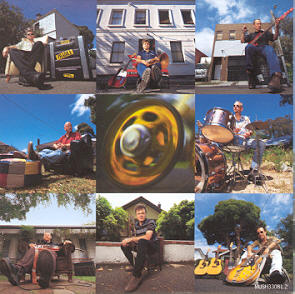
Juggernaut Band Photos, 1998
During 1998 Mushroom re-released Talking To A Stranger (#204) as part of their ’25th Anniversary’ celebrations. The single contained a new live version along with the original, five remixes, and video’s of the live and studio versions.
In November 1998 the third Hunters and Collectors live album was released. Under One Roof (#21, AMR), initially released as a CD and VHS video, was recorded at Selina’s in Sydney as a form of ‘best of’ to mark the end of the band. At the time, Under One Roof was the definitive Hunters live document, being high quality and close to a full concert in length. Under One Roof was repackaged as Greatest Hits Live in June 2011 (#103).
The Hunters and Collectors contract expired with Festival Mushroom Records in April 2003, which was followed by a new contract with Liberation Records. This was great for fans as a swag of new releases appeared from mid 2003. First off were remastered versions of all the studio albums by August 2003. What’s A Few Men? was re-released with additional tracks from the no longer available Fate included.
A new studio best-of compilation, Natural Selection, (October 2003), brought Hunters and Collectors back into the Australian albums chart (#40, Platinum). The first Hunters and Collectors DVD’s soon appeared in the form of the comprehensive studio video compilation Natural Selection (November 2003) and Under One Roof (November 2003, #31). The Natural Selection CD and DVD were repackaged as Greatest Hits in October 2011 (#217).
Liberation Records continued to work the Hunters and Collectors back catalogue. The Way To Go Out was released on DVD in June 2004 and a remastered CD in August 2004. A rarities album Mutations was released in September 2005, containing almost all studio b-sides from the Hunters and Collectors back catalogue. In September 2006, a 20th anniversary edition of the Human Frailty album was released, including a bonus DVD of video clips and RockArena live footage. Living In Large Rooms and Lounges reappeared in stores in June 2007. Great Australian Albums featured Human Frailty in 2008, resulting in a SBS documentary DVD being released in October 2008.
The ‘Holy Grail’ for Hunters and Collectors was released in November 2008 in the form of a 16 disc box set. A wood grain appearance solid cardboard box package, Horn of Plenty contained the nine standard studio albums on CD, the Mutations CD, the three EP’s on a CD called Cargo Cult, a rarities CD titled Spare Parts, the two CD Living In Large Rooms and Lounges, Under One Roof and The Way To Go Out on one DVD and a remastered Natural Selection DVD. This remains the ultimate Hunna’s document.
From the final concerts in 1998 to 2012, Hunters and Collectors played together only three times. The first was to perform two songs upon their induction into the ARIA Icons Hall of Fame in 2005. The second was for the 2009 Melbourne Sound Relief concert in support of Victorian bush fire victims. All eight Hunters songs performed appeared on the Sound Relief 4 DVD set released in October 2009 (#2, 5 Platinum).
The third was an entirely unexpected full gig in 2011, a full thirteen years after the last. As the closing act for the Sydney V8’s Saturday afternoon concert, the Hunna’s played 17 songs during their 90 minute set. All the hits were given a run while fans of all eras were catered for with tracks ranging from Head Above Water to Dog to Little Chalkie to a hypnotic Skin of Our Teeth.
The semi-official Internet site True Believers was permitted exclusive access to hundreds of Hunters and Collectors recordings in July 2012. With assistance from Rob, Jack and John, a mass digitisation process was undertaken to document Hunters history. For fans, this resulted in a weekly Vault ‘rare track of the week’, which ran for four years and supplied a remarkable 238 separate CD quality digital audio tracks.
The moons came into alignment in 2013, which turned out to be the biggest year for the Hunna’s since disbanding. First a mighty tribute album Crucible was announced for September featuring Neil Finn, Eddie Vedder, Paul Kelly, Something For Kate, The Living End, Birds of Tokyo, The Avalanches and a stunning collection of highly regarded musical artists. Then a substantial reunion was gradually announced, including a performance at the AFL Grand Final, two gigs with Bruce Springsteen, four theatre shows, ten A Day On The Green gigs and New Zealand gigs at the Powerstation and supporting The Rolling Stones. On the back of all the activity, Hunters stormed back into the Australian consciousness and album charts with Crucible (#3).
The 2014 tour was wildly successful with most concerts selling out and picking up a prestigious Helpmann Award for Best Australia Contemporary Concert. Authentic recordings from Sydney’s Enmore Theatre and Melbourne’s Palais Theatre appeared on the limited edition crowd funded 4 CD Live 2014 box set. Containing two full concerts each over two discs, these recordings are the penultimate Hunters live recordings. The full two hour Palais recording was made available digitally in April 2017 as “Live 2014”.
A new digital only best of, Anthology, appeared in August 2015. With forty hours and nearly three hours of music, Anthology is a beast of a collection. For the first time outside of video compilations, it included Judas Sheep and Sway from The Fireman’s Curse, suggesting softening perspectives on the era.
Post tour all was quiet in Hunters and Collectors world until a one off reunion gig for the 2017 Adelaide Clipsal 500 V8’s event. For one Saturday evening in March, fans new and old were rewarded by a powerful concert featuring all the hits and choice album cuts.
The resurgence of vinyl as a format allowed Hunters and Collectors vinyl to reappear in 2017. First Human Frailty was released in August followed by Cut in November and Ghost Nation in September 2018. Cut, in celebration of it’s 25th anniversary, was also re-released at the same time as the vinyl. Featuring unreleased demo versions, unreleased b-sides and far more, the expanded digital and CD version of Cut was a first of it’s kind from the band.
As part of the Red Hot Summer Tour, Hunters and Collectors blasted back onto the scene for early 2020. The biggest tour since 1998 also featured James Reyne, The Living End, The Angels, Baby Animals, Killing Heidi and Boom Crash Opera. Unfortunately the planet had alternate plants as it buckled under pressure, unleashing wild weather and a virus pandemic. Fifteen gigs were completed, two were cancelled due to unruly wind, two were cancelled due to flooding rains and nine were lost due to Covid-19. The good news is the gigs were well attended and three were postponed until 2022: so the live story continues.
Besides the postponed Red Hot Summer dates, Hunters have no further plans to play together. However, this has been the on and off status since 1998 – so fans remain perpetually hopeful that one of Australia’s finest will do ‘just one more’!
Trumpet player Jack Howard and vocalist Mark Seymour have solo music careers.
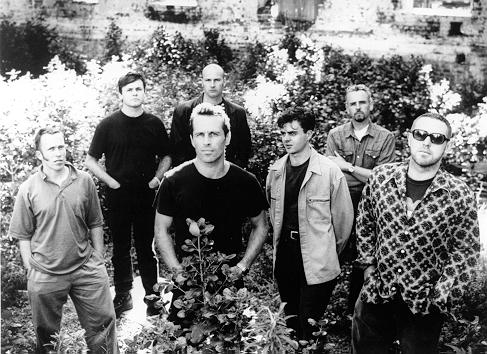
1998 Hunters and Collectors Band Photograph
Jack Howard
Jack Howard, the trumpet player and a backing vocalist in Hunters and Collectors, has an established solo career. Musically, Jack’s solo material tends to be darker and more melancholic than Mark Seymour’s, making it some ways closer to the moods in the music of Hunters and Collectors. Jack plays regularly around Melbourne with a series of talented musicians and friends.
In March 2000 Jack Howard released a low key solo EP called Lo Stresso Tempo. It was a raw five track rock EP with Home as a standout track.
Jack’s first full solo studio album, Secrets and White Lies, was released in July 2002 through Laughing Outlaw Records. The new album is a lot bigger and stronger than his first solo effort, the Lo Stresso Tempo EP. Dominating melodic drum and bass rock combines in Secrets with a touch of country and jazz to form an impressive album. Favourites include You Will Find, Heard You Cry, Sail Upon Her Smile and title track Secrets and White Lies.
Jack Howard had regular Friday night gigs at the Elwood RSL during 2002 and 2003 with his band The Long Lost Brothers. Jack Howard also played in The Elwood Dad’s Band through 2002, a collection of musical fathers who all have children attending Elwood Primary School. Whilst involved in all of these and many other musical endeavours, Jack Howard recorded a second solo album called Let’s Fall In Love, which was released in October 2004. Choice picks include Pendulum, Let’s Fall In Love, I Just Don’t Understand and the cover Sea Of Love.
Jack’s third studio album, My Lucky Day, was released in July 2007. The base 11 track full band album was complemented by six stripped back tracks featuring John Berto on electric guitar. The base album contained Will You Wait and Dial-A-Prayer, while Don’t Fade Away from the later tracks is among Jack’s best. Jack’s ability to form a great band is reflected again in the superb musicianship on the My Lucky Day album.
The Lost Horizon album appeared in November 2009, made on a shoestring budget yet sporting an impressive range of talented young musicians, many met in Jack’s day job as a music teacher at Melbourne’s Wesley College. Finding critical acclaim, the 9 track album featured many new favourites, including Crescent Moon and Lost Horizon. A video clip was made for the beautiful If I Were A Bird.
2012 was a big year for Jack Howard, launching and supporting a new studio album Shadowlands (January), a comprehensive best of with bonus live DVD The Story So Far (October), and a b-sides and rarities set The Story So Far (October). New and old favourites abounded, with the sound of Jack and his trumpet heard far and wide in various projects and bands. A Fred Negro cartoon characterised a 2012 night out in Melbourne well – “it was a night when too much Jack Howard was not enough”!
For 2013, Jack Howard became a full member of surf rock instrumental outfit The Break prior to the release of their Space Farm album. Jack was involved in both recording and touring duties. The Break also features Rob Hirst (drums), Jim Moginie (guitar, theramin, keys, producer), Martin Rotsey (guitar) and Brian Ritchie (bass).
Day of the Dog, released during the Hunters and Collectors 2014 activities, featured many of Jack’s most accomplished recordings to date (April 2014). A reformed Long Lost Brothers supported with Mark Ferrie (bass), Ed Bates (pedal steel), Nicky Del Rey (guitars) and Cal McAlpine (drums). A video was created for the infectious and moody The Lark Ascends, enjoyed by fans and reviewers alike.
Ever prolific, Jack Howard released three separate recordings during 2015. The first was a full album collection of duo recordings with John Berto, the style of which was first seen on My Lucky Day, as The Inverloch Tapes (January). A collection of Burt Bacharach and Hal David tunes from Jack’s The Look of Love live shows, titled the The Look Of Love EP, came next under the band name Jack Howard and The Ambassadors Of Love (March). Finally, the poems of Dawson Hann were brought to life on the Songs For Longing – The Poems of Dawson Hann EP in August.
Early 2016 saw the release of The Passing Parade EP (February 2016), featuring six warm pop tracks. A video was created for A Foggy Night, a track capturing the chilled sensation of late night driving. Long time compadre Nicky Del Rey provided guitar and Heather Michael backing vocals.
Jack Howard formed an exciting new outfit in 2016 called Epic Brass to deliver the brassy best of Australia’s horn history. Performing the hits and gems of Hunters and Collectors, Midnight Oil, The Saints, Laughing Clowns, X and more in the presence of an impressive rotating array of special guests, Epic Brass continues to gig sporadically. A taste can be found on the Epic Brass – Live At Memo digital album (October 2016) and more recent Epic Brass – Live At The Gershwin Room (July 2021).
An invitation not to be refused resulting in Jack joining the Midnight Oil Great Circle world tour during 2017. Beyond trumpet, Jack filled a a myriad of cowbell, keyboard, backing vocal, flugel horn and lemon shaker roles. The massive tour included over 70 gigs mainly across South America, the USA, Canada, Europe and Australia. The experience inspired Jack’s post tour album LightHeavyWeight (October 2018), a journey across international times and places.
The challenges faced by Covid-19 and related isolation saw a particularly creative period for Jack during 2020. Isolation itself led to the Bathrobe Beats EP (April 2020), including an memorable ode to his beloved Ciccolina’s restaurant in St Kilda. The Long Lost Brothers also returned to recording, delivering the cracking Dog Songs album in September 2020. Complimenting Dog Songs was Jack’s own autobiographical book, Small Moments of Glory, which proves there are always insufficient words to describe all of Jack’s musical adventures.
As at 2021, Jack can be found playing at various haunts around Melbourne when possible.
Mark Seymour
Mark Seymour continued to promote his first solo album King Without A Clue (#53) during 1998 after the Hunna’s split. The album spawned a total of four singles -Last Ditch Cabaret (April 1997, #85), The Ghost Of Vainglory (#152, October 1997), Home Again (July 1998, #201) and You Don’t Have To Cry Anymore (#202, September 1998). Mark Seymour’s solo album showed a more radio friendly acoustic guitar pop sound than his former band. Mark’s preferred touring was solo with an acoustic guitar, though some gigs were performed with his brother Nick Seymour of Crowded House fame, or more regularly with Rod Davies. Robert Miles continued to work with Mark Seymour, taking care of Mark’s live sound whilst working as an architect for a ‘day job’.
Mark Seymour returned in March 2001 with the exceptional One Eyed Manalbum (#67). The first single Don’t You Know Me? (#153, February 2001) excited fans but lacked airplay. A second album track, the brilliant Ballad Of The One Eyed Man, was released as a promo single only. The record company, Festival Mushroom Records, was not interested in more commercial singles. On an album full of catchy melodic pop rock the standout tracks included Sad Songs, Blue Morning, Always A Fool (For A Pretty Face) and On My Way Home. The album quality was recognised at the 2001 ARIA Awards with a win for Best Adult Contemporary Album.
Mid way through 2001 Mark Seymour parted ways with Festival Mushroom Records after a twenty year association. Mark linked up with Warner for The Ballad Of The One Eyed Man Live At The Basement DVD in November 2001. A CD version was in turn released in February 2002 through the Basement and Warner. The performances on these releases were taken from Mark Seymour’s gig at the Basement nightclub in Sydney on the 10th of July 2001. A number of previously unreleased songs featured on these releases.
Recording for Mark Seymour’s third solo album, Embedded (#159), was completed by June 2003 and the album was released in April 2004. Claimed by many to be Mark’s most cohesive album to date, Embedded presented a collection of dark tales from the suburbs. Embedded featured the radio only singles Try Not To Try (September 2003), 43 In The Shade (March 2004) and Shoulder To Cry On (July 2004). Other highlights included Mark’s ode to his former record company Made Man, a dedication to the anxiety of modern living in Left Alive and live favourite In The Kitchen Of A Perfect Home.
Joining the Liberation Records Liberation Blue Acoustic Series, Mark recorded and released two live in studio acoustic albums, Daytime and the Dark (#99, March 2005) and Titanic (#197, September 2007). The albums contained mainly Hunters and Collectors songs with a few Mark solo tracks. Some songs, such as Throw Your Arms Around Me and promotional single Do You See What I See?were predictably great, while unexpected pleasures were found in the likes ofThe Slab and Talking To A Stranger. A cracking duet with James Reyne of Dragon’s April Sun in Cuba also appeared at this time, coinciding with Mark’s co-headlining tours with James Reyne. A compilation of these two albums was released as The Closest Living Thing in Scandinavia (May 2008) and Canada (June 2009).
Mark’s fourth solo album, Westgate (#128), arguably Mark’s most accomplished album to date, was released in June 2007. Westgate merged Mark’s interpretations of society and relationships with more direct political commentary. Title trackWestgate told the story of the 1970 Westgate bridge collapse from the perspective of worker Ed Halsall. Master of Spin was inspired by soon to be voted out Australian conservative Prime Minister John Howard and former Soviet Union leader Nikita Khrushchev. The yearning Walk Through Fire, haunting Mississauga and eerily realistic Love is a Heavy Load also became classics.
On the cold night of the 27th of September 2007, Mark fans gathered at the Espy in St Kilda, near Melbourne, for the recording of a live Mark Seymour video. The gig featured mainly material from the Westgate album, along with selected Hunna’s and other Mark solo tracks. The resulting From Bondi to Bedlam DVD, released in December 2007, was am accurate capturing of this memorable gig. A combined CD and DVD release appeared in 2009.
Determined to follow a band approach, Mark formed Mark Seymour and the Undertow in 2010 with Cameron McKenzie (guitars, vocals, keys), John Favaro (bass, vocals) and Peter Maslen (drums, vocals). The first result was the self titled Undertow (#51) in June 2011, a well received album that went on to earn a 2011 ARIA Award nomination for Best Adult Contemporary album. Opener Castlemaine hinted at Mark’s folk interests, The Legend of the Snowmen dealt with asbestos workers while Classrooms and Kitchens covered the challenging subject of Mark’s elderly mother Paula’s dementia. A video clip was made for the wistful Cry in the Rain.
Seventh Heaven Club in March 2013 (#116) saw Mark follow his heart with a cover album of favoured love songs from the last few decades. Mark skilfully places his own twist on some well known and less known originals from artists including The National (Sorrow), Bob Dylan (Can’t Wait), and Dave Dobbyn (Beside You). Notable guest appearances included his daughter Hannah on Lorelei and Caroline, Abby Dobson on Getting Over You and Lucinda Williams on Come On. Promotional singles were issued for Lorelei / Beside You and Getting Over You.
The critically acclaimed Mayday appeared in May 2015, bringing Mark into the top 50 albums for the first time in his solo career (#43). The personal and political merged in the most challenging and engaging lyrics of Mark’s career. Mayday was a cohesive and compelling set of songs backed by The Undertow in fine form. Four promotional videos followed for Football Train, Two Dollar Punter, Home Free and Red Flags.
Recorded in front of fans at Melbourne’s Bakehouse in June 2016, the crowd funded live retrospective album Roll Back the Stone appeared in April 2017 (#55). The Undertow rips through twelve Hunters and a further twelve solo tracks across the double album. Fan Hunters favourites including Still Hanging ‘Round and Everything’s On Fire star but the Undertow shines most brightly with live renditions of recent solo tracks including Classrooms and Kitchens, Courtroom 32 and Kosciusko.
In yet another reinvention, Mark’s album Slow Down (May 2020) wove together tales of our past and present into the future with a fitting document of the times. The release and touring frustrated by Covid-19 and lockdown challenges, videos appeared for Night Driving, Kliptown Mud, Slow Dawn and lullaby-esque The Whole World Is Dreaming. Slow Dawn also became Mark’s first solo vinyl release.
As at the 2021, Mark continues to tour around Australia when possible.
